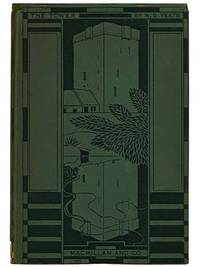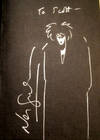London: Macmillan and Co., Limited, 1928. First Edition. Hard Cover. Near Fine/Very Good. 7x5x0. Moore, Thomas Sturge (cover and jacket design). First edition, one of 2500 copies (Wade 158). Includes scarce jacket. 1/2 inch chips from jacket spine head and foot, and corner of rear panel, with minimal loss along other edges. Binding tight, pages clean and bright, boards in excellent condition with all gilt decorations still present. 1928 Hard Cover. vi, 110, 2 pp. Green cloth with elaborate gilt decorations by Thomas Sturge Moore, mirrored in the jacket design. "...the greatest poetry of Yeats in his difficult later manner... Yeats, however complicated his thought, remained a consummate musician in his expression of it..." (Connolly, The Modern Movement 56a) Includes: Sailing to Byzantium; The Tower; Meditations in Time of Civil War; Nineteen Hundred and Nineteen; The Wheel; Youth and Age; The New Faces; A Prayer for My Son; Twon Songs from a Play; Wisdom; Leda and the Swan; On a Picture of a Black Centaur by Edmond Dulac; Among School Children; Colonus' Praise; The Hero, the Girl, and the Fool; Owen Ahern and His Dancers (The Lover Speaks, The Heart Replies); A Man Young and Old; The Three Monuments; From 'Oedipus at Colonus'; The Gift of Harun Al-Rashid; All Souls' Night; Notes. Comprises "...the summit of Yeats's creative achievement in these years is represented in The Tower (1928). This volume, decorated with one of Thomas Sturge Moore's most beautiful cover engravings, depicting Ballylee and its reflection, brought together the poems quarried out of new sources, expressed in new language. At the same time, as Richard Ellmann remarked of the breathtaking opening poem 'Sailing to Byzantium', Yeats had in a sense been writing them all his life. Thus that poem is a distillation of his well-established themes of human old age, the mutability of nature, and the eternity of art—but viewed quizzically through the prism of a millennial Byzantium created from his supercharged imagination and wide if erratic reading. As such, it has magnetized a phalanx of scholars but retains the quintessential Yeatsian combination of mystery and accessibility... The Tower also contains his two great sequences about history and violence, inspired by the Bolshevik as well as the Irish revolution—'Nineteen Hundred and Nineteen' and 'Meditations in Time of Civil War'. The first interrogates 'the present state of the world' (its original title) through a complex commentary on cyclical history and personal disillusionment... 'Meditations' meanwhile, suggests, doubtfully enough, that the apocalyptic horses of destruction can herald a new creativity and growth, arising out of the wreckage of a superficially assured civilization. A volume that also includes 'Among School Children' and 'All Souls Night' has to be reckoned at the height of his achievement. While the personal voice is as dominant as ever, Yeats also demonstrates a new ability to raise abstruse philosophical questions in a language at once mobile, exploratory, and economical. He thought it the best book he had written, and he was right. The Tower also contains 'Leda and the Swan', written five years before, and already notorious. That recurring theme of the birth of civilizations through acts of violence was cast into shadow by the immediacy of the erotically charged imagery when Yeats published it in To-morrow, a short-lived magazine edited by Iseult and her husband, Francis Stuart (1902–2000), which had successfully outraged Irish Catholic piety. This was a deliberate strategy: Yeats also contributed an anonymous editorial, designed to provoke the self-righteous. From the early days of the new Irish Free State he set himself up as the scourge of artistic and literary censorship, not always with the approval of fellow protestants who preferred not to rock the boat. Though the Yeatses first lived in Oxford after their marriage, George had encouraged her husband's instinct to return to Ireland and from early 1922 they divided their time between a Dublin town house and the tower at Ballylee. The Irish civil war rumbled in the background, and its reverberations echo in 'Meditations in Time of Civil War', written at this time... The upheavals of Irish politics also brought Yeats back into public life. In 1923 he was nominated to the senate of the new Irish Free State, where he took an active role over the next five years, chairing the committee appointed to choose a new coinage for the country, and making celebrated speeches against the imposition of Catholic social teaching in Irish constitutional law. He used his public position on occasions like the Tailteann games (August 1924), as well as his platform in the senate, to further the cause. But the tide of opinion was against him, and the attitudes he struck during the 1920s and 1930s would be held against him in perpetuity. At the same time his espousal of artistic freedom and celebrated pronouncements against the prohibition of divorce (1925) conferred a special position in Irish public life. And though he saw himself as seeking, and finding, an 'Anglo-Irish solitude', he could not stop throwing himself into public controversy when the opportunity arose. In another key poem, 'Among School Children', Yeats described himself during his senate years as 'a smiling public man', but the smile was not always in evidence. As a politician and a poet he was always conscious that there was an audience to be addressed; this could be both a strength and a weakness. Significantly, 'Among School Children' ended by posing profoundly unanswerable Neoplatonic questions; for the centre of his imaginative life remained far from politics, a fact amply if rather mystifyingly demonstrated in A Vision, published in 1926. Relying on the interrogations and reflections pursued through George's automatic writing, this strange book codified human archetypes and historical cycles into a framework based on the twenty-eight phases of the moon; arcane philosophy had in some measure replaced the magical quests and rituals of the Order of the Golden Dawn, though he kept up his connection with that organization as late as 1922. In both these involvements his wife's influence was discreet but decisive: her wide reading in esoterica inform the resourceful responses which make up the vast corpus of ‘Automatic Script' analysed by scholars. A Vision is an attempt to fashion a personal philosophy, and to codify historical change, on lines that have been described as 'Gnostic-Apocalyptic'. It might also be seen (in a private description of Oliver St John Gogarty's) as 'a geometrical rendering of the emotions, a mixture of Einstein and myth' (unpublished letter to L. A. G. Strong, 26 Jan 1926, University of Texas at Austin). Several of its preoccupations had been aired in the two essays on art and the spiritual life published as Per amica silentia lunae in 1918: George had seen the proofs during the first days of their marriage, and her 'instructors' had clearly taken them to heart. When writing Per amica Yeats had characteristically written to Craig... This neatly expresses his enduring belief in the interconnectedness of supernatural and everyday life, which tended to bewilder his more earthbound acquaintances, but was deeply rooted in his early devotion to Swedenborg and more especially William Blake—an admiration that never left him. At the same time, the strength of Yeats's work—and some of his finest poetry was written in the 1920s—was also rooted in direct personal experience. It is not coincidental that he was simultaneously continuing his reflective Autobiographies, and still fighting hard battles over the Abbey Theatre (notably regarding the new dramatic genius Sean O'Casey, whose early plays provoked riots reminiscent of the reaction to Synge, but who broke with Yeats and Gregory when they turned down his experimental anti-war play The Silver Tassie in 1928). Yeats's international status was recognized by the award of the Nobel prize in 1923, which brought him some financial capital for the first time in his life; the lecture which he gave on the occasion, published in 'The Bounty of Sweden', stands as one of his most influential essays in autobiography. Augustus John's second portrait, of 1930, depicts Yeats in his maturity, with his disciplined mane of white hair and pugnacious lower lip. He was by now one of Dublin's great established figures, both in his own right and as the representative of the cultural renaissance which—it was generally held, and unequivocally stated by Yeats himself in his speech receiving the Nobel prize—had set in motion the Irish revolution and war of independence." (Oxford Dictionary of National Biography

(US)






